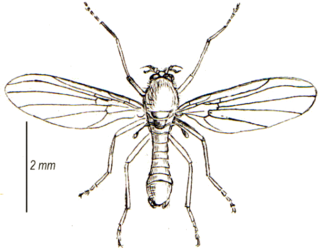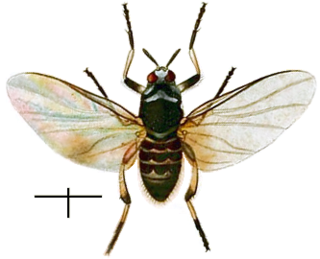
Sandfly is a colloquial name for any species or genus of flying, biting, blood-sucking dipteran (fly) encountered in sandy areas. In the United States, sandfly may refer to certain horse flies that are also known as "greenheads", or to members of the family Ceratopogonidae. The bites usually result in a small, intensely itchy bump or welt, the strength of which intensifies over a period of 5-7 days before dissipating. Moderate relief is achieved with varying success through the application of over the counter products such as Benadryl (ingested) or an analgesic cream such as After Bite. Outside the United States, sandfly may refer to members of the subfamily Phlebotominae within the Psychodidae. Biting midges (Ceratopogonidae) are sometimes called sandflies or no-see-ums. New Zealand sandflies are in the genus Austrosimulium, a type of black fly.

Manaaki Whenua – Landcare Research is a New Zealand Crown Research Institute whose focus of research is the environment, biodiversity, and sustainability.

A black fly or blackfly is any member of the family Simuliidae of the Culicomorpha infraorder. It is related to the Ceratopogonidae, Chironomidae, and Thaumaleidae. Over 2,200 species of black flies have been formally named, of which 15 are extinct. They are divided into two subfamilies: Parasimuliinae contains only one genus and four species; Simuliinae contains all the rest. Over 1,800 of the species belong to the genus Simulium.

Thaumaleidae, the solitary midges or trickle midges, are a group of nematoceran flies related to the Ceratopogonidae, Chironomidae, and the Simuliidae. They are small, stocky, yellow to brown flies (3–4 mm). Very few species are known for this family. Larvae are found in films on rocks and the nonfeeding adults are usually found on foliage along the same streams in which the larvae are found. A few solitary midges are found in the Southern Hemisphere, but Thaumaleidae are generally an Holarctic family.

Simulium is a genus of black flies, which may transmit diseases such as onchocerciasis. It is a large genus with several hundred species, and 41 subgenera.

The Simuliini is a tribe of black flies that contains over 2,000 species, with more than 1,800 in the genus Simulium. There are 19 living genera, and three genera only known from Cretaceous fossils.

Austrosimulium is a genus of 31 species of black flies that are distributed in Australia and New Zealand. There are 2 subgenera: Austrosimulium whose species are principally from New Zealand, and Novaustrosimulium which are exclusively Australian. Austrosimulium is a sister genus to the monospecific Paraustrosimulium of South America.
Ectemnia is a genus of 4 species of black flies. They are distributed in North America.
Novaustrosimulium is a subgenus of Austrosimulium, a genus made up of black flies. The flies in this subgenus are found exclusively in Australia.
Austrosimulium ungulatum, known by the common name West Coast black fly or just sandfly, is a species of small fly of the family Simuliidae that is endemic to New Zealand. Females consume blood for nutrients to produce eggs and it is one of three species of Austrosimulium in New Zealand that often bite humans.

Kikihia cutora, the snoring cicada, is a species of cicada that is endemic to New Zealand. This species was first described by Francis Walker in 1850.

Kikihia longula, commonly known as the Chatham Island cicada, is a species of cicada that is endemic to New Zealand. This species was first described by George Hudson in 1950.

Kikihia subalpina, commonly known as the subalpine green cicada, is a species of cicada that is endemic to New Zealand. This species was first described by George Hudson in 1891.

Maoricicada hamiltoni, also known as the Hamilton's cicada, is a species of insect that is endemic to New Zealand. This species was first described by John Golding Myers in 1926. This species is named in honour of Harold Hamilton.

Maoricicada lindsayi, also known as the Lindsay's cicada, is a species of insect that is endemic to New Zealand. This species was first described by John Golding Myers in 1923. Myers named the species in honour of Charles Lindsay who collected the holotype specimen.

Rhodopsalta leptomera, also known as the sand dune redtail cicada, is a species of insect that is endemic to New Zealand. This species was first described in 1921 by J. G. Myers and named Melampsalta leptomera.
Brenda Mabel May was a New Zealand speleological entomologist known for her contributions to the understanding of weevil larvae biology. Between 1956 and 1980, she worked in the Entomology Division of the Department of Scientific and Industrial Research (DSIR). Afterwards, she became a research associate at Landcare Research, where she completed a systematic overview of New Zealand Curculionoidea, published in 1993. In 1998, May was elected as a Fellow of the Entomological Society of New Zealand in recognition of her contributions.
Mnesarchella stellae is a species of primitive moths in the family Mnesarchaeidae. It is named in honour of Gibbs' mother Florence Stella Gibbs. This species is endemic to New Zealand and can only be found in the Nelson area for recording specimen localities as described by T. K. Crosby. This species is the largest in the Mnesarchella genus but otherwise is similar in appearance to other species contained in that genus. This species prefers very damp, dark native beech forest with plentiful moss and lives at altitudes of between 420 and 750 m. Adults of this species are on the wing in December and January.
Rhopalimorpha is a genus of insects in the shield bug family Acanthosomatidae. It is native to Australia and New Zealand. There are four species in the genus, of which three are found in New Zealand.

Austrosimulium australense, known as the New Zealand black fly or more commonly sandfly, is a species of small fly of the family Simuliidae, endemic to New Zealand. Females consume blood for nutrients to produce eggs, and it is one of three species of Austrosimulium in New Zealand that often bite humans.













